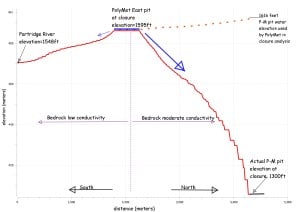
A flaw in the final environmental impact statement for the proposed PolyMet copper-nickel mine in northeast Minnesota means groundwater discharge could flow into the Boundary Waters watershed, the Timberjay newspaper has reported. For as long as the project has been planned, officials have stated it would be solely in the St. Louis River-Lake Superior watershed.
The problem was first pointed out by tribal scientists in August. The state responded that it would address the issue in the final EIS, which was released in early November. The tribes says it was not fixed, and the DNR now agrees that the calculations are wrong. The model assumes the water in the Peter Mitchell taconite mine pit a mile north of PolyMet’s proposed mine would be higher than that in PolyMet, pushing groundwater into PolyMet, rather than the other way around.
The DNR says the incorrect model was not intended to look at groundwater flows out of the PolyMet mine, but rather to estimate how much groundwater would enter the mine pit and need to be pumped out and treated. The Timberjay cites this estimate of 700 gallons per minute entering the PolyMet mine from the north as evidence that the two areas are connected underground, even if on the surface they sit on either side of the continental divide.
“In official comments to the lead agencies, [John] Coleman [of the Great Lakes Indian Fish and Wildlife Commission] argues that if the model incorporates actual expected water levels in the two pits, the water in NorthMet’s east pit is 300 feet higher and the model predicts a substantial northward flow of untreated mine water,” the Timberjay reports. “That’s a point that DNR officials now concede.”
If groundwater does flow from PolyMet to the Peter Mitchell mine pit, it could then flow downstream to Birch Lake, down the South Kawishiwi River, and into the Boundary Waters Canoe Area Wilderness. It could also feed wetlands, which can create more mercury contamination in fish when the levels of a key PolyMet pollutant, sulfate, increases.

